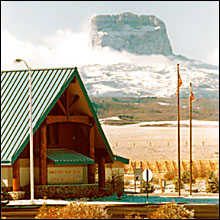Archives
Emerging building type showcased
James Dyett Gallery to show border station architecture
By PATRICIA DONOVAN
Contributing Editor
Border station architecture is an emerging building type. In fact, border stations did not exist in this country until the early decades of the 20th century, and then were modest in form and domestically scaled.

Among the border stations featured in the Dyett Gallery is this one at Port of Piegan, Mont.
In the past 25 years, however, they have grown in number, size, complexity and design sophistication, both here and abroad, and today integrate advanced security, incorporate sustainable design strategies and frequently include commissioned art.
"Thresholds Along the Frontier: Contemporary U.S. Border Stations," a traveling exhibition of newly designed U.S. international border stations, was developed by the General Services Administration (GSA), which commissioned the new border stations.
The free exhibit, which premiered in the James Dyett Gallery in the School of Architecture and Planning on Feb. 1, will continue through March 13 before traveling to other venues in the U.S. and Canada.
The Dyett Gallery is located in Hayes Hall, South Campus, and is open to the public from 9 a.m. to 5 p.m. Monday through Friday.
The exhibition includes text and image panels, architectural models and art maquettes (small models of intended art work) of several of the commissioned structures, some of which are built and others that are in the construction process.
The GSA says it developed the exhibit to "provide the American public with an opportunity to see contemporary design in border station architecture."
"Crossing the border between the United States and Canada or Mexico is a significant experience (and one) increasingly distinguished by iconic architecture," says David Winstead, commissioner of the GSA Public Building Service, which is responsible for the design and construction of border stations for the Department of Homeland Security Bureau of Customs and Border Protection. U.S. border stations, he notes, "strive to convey a sense of openness and welcome that is a hallmark of America's history."
The U.S. Department of Homeland Security's five-year border-crossing expansion program includes plans to enhance and rebuild many of the existing 167 border stations along the Canadian and Mexican borders to meet modern security and commerce needs.
The project has provided business opportunities for architecture and engineering firms involved in what The Wall Street Journal called a "serious architectural makeover...(including) a campaign to elevate (the) structures into memorable pieces of civic architecture." It's estimated the project will cost several billion dollars.
Among the notable projects that have evolved from the program is the U.S.-Canadian International Border Station that straddles the U.S.-Canada border at Port of Piegan, Mont. It was designed by CTA Architects Engineers to reflect a nearby building in Glacier National Park that was built in the 1930s and to be harmonious with the station's mountainous backdrop. In addition, CTA's design concept recalls the Native American Blackfoot culture, which also straddles the U.S.-Canadian border in that region.
Also notable are the award-winning designs for the Sault Ste. Marie Port of Entry, designed by Ross Barney + Jankowski Inc. Architects, and the Sweet Grass, Montana-Coults, Alberta, station, located on a remote northern prairie. The latter was designed and built by McGraw-Hill Construction Design-Build to accommodate the third-largest crossing in the western U.S. and Canada.
The San Ysidro U.S.-Mexico Border Station project is a $125 million landmark project that will not be completed until 2011. It is, however, already the subject of local, national and international praise and publicity. The project was designed and is being built by URS, one of the largest engineering design firms worldwide and a leading U.S. federal government contractor.
